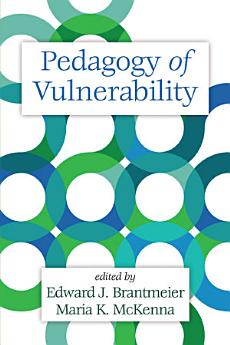Pedagogy of Vulnerability
Edward J. Brantmeier · Maria K. McKenna
mars 2020 · IAP
E-book
295
Pages
family_home
Éligible
info
reportLes notes et avis ne sont pas vérifiés. En savoir plus
À propos de cet e-book
The purpose of this text is to elicit discussion, reflection, and action specific to pedagogy within education, especially higher education, and circles of experiential learning, community organizing, conflict resolution and youth empowerment work. Vulnerability itself is not a new term within education; however the pedagogical imperatives of vulnerability are both undertheorized in educational discourse and underexplored in practice. This work builds on that of Edward Brantmeier in Re-Envisioning Higher Education: Embodied Pathways to Wisdom and Transformation (Lin, Oxford, & Brantmeier, 2013). In his chapter, “Pedagogy of vulnerability: Definitions, assumptions, and application,” he outlines a set of assumptions about the term, clarifying for his readers the complicated, risky, reciprocal, and purposeful nature of vulnerability, particularly within educational settings. Creating spaces of risk taking, and consistent mutual, critical engagement are challenging at a moment in history where neoliberal forces impact so many realms of formal teaching and learning. Within this context, the divide between what educators, be they in a classroom or a community, imagine as possible and their ability to implement these kinds of pedagogical possibilities is an urgent conundrum worth exploring. We must consider how to address these disconnects; advocating and envisioning a more holistic, healthy, forward thinking model of teaching and learning. How do we create cultures of engaged inquiry, framed in vulnerability, where educators and students are compelled to ask questions just beyond their grasp? How can we all be better equipped to ask and answer big, beautiful, bold, even uncomfortable questions that fuel the heart of inquiry and perhaps, just maybe, lead to a more peaceful and just world? A collection of reflections, case studies, and research focused on the pedagogy of vulnerability is a starting point for this work. The book itself is meant to be an example of pedagogical vulnerability, wherein the authors work to explicate the most intimate and delicate aspects of the varied pedagogical journeys, understandings rooted in vulnerability, and those of their students, colleagues, clients, even adversaries. It is a work that “holds space.”
Donner une note à cet e-book
Dites-nous ce que vous en pensez.
Informations sur la lecture
Smartphones et tablettes
Installez l'application Google Play Livres pour Android et iPad ou iPhone. Elle se synchronise automatiquement avec votre compte et vous permet de lire des livres en ligne ou hors connexion, où que vous soyez.
Ordinateurs portables et de bureau
Vous pouvez écouter les livres audio achetés sur Google Play à l'aide du navigateur Web de votre ordinateur.
Liseuses et autres appareils
Pour lire sur des appareils e-Ink, comme les liseuses Kobo, vous devez télécharger un fichier et le transférer sur l'appareil en question. Suivez les instructions détaillées du Centre d'aide pour transférer les fichiers sur les liseuses compatibles.





